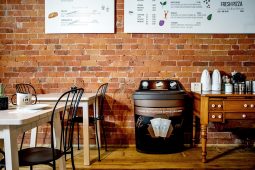A lot of people have food on the brain – well, food waste, that is! States like California and Massachusetts – and now New York – are mandating organic waste diversion programs, and organizations across Canada and the US are moving compost & food scrap collections to the top of their priority list.
Have no fear! Busch Systems is here with a breakdown of what’s going on in the organic waste world and how you can start or upgrade an organic waste program as painlessly as possible!
In a New York State of Mind?
First things first – New York State is one of the latest states to pass legislation regulating the treatment of food waste. Under New York State’s Food Donation and Food Scraps Recycling Law, effective January 1, 2022, “businesses and institutions that generate an annual average of two or more tons of food scraps per week must:
- Donate excess edible food, and
- Recycle all remaining food scraps if they are within 25 miles of an organics recycler with excess capacity.”
For a deeper dive into the specific regulations, visit New York State’s Department of Environmental Conservation website here, and you can view a full list of Food Scrap Transporters working in New York State here.
Has your business or institution been designated a Food Scrap Generator (DFSG)? We can help!
Food Scrap Collection & Diversion
Whether there’s new legislation coming down the pipe, or you’ve got your own waste reduction & diversion goals to meet, you’re reading this blog because you need to start or level-up a food scrap program. Before we take a deep-dive, here are a couple resources that are specifically geared toward helping you navigate and adapt to legislated organic waste programs and bans:
- Into the Green Bin: Collecting Food Waste from Institutional Settings – the replay & recap of our January 2022 webinar, complete with a comprehensive list of resources & downloads provided by our panel of experts!
- BANS AND BEYOND: Designing and Implementing Organic Waste Bans and Mandatory Organics Recycling Laws
- Sustainable Management of Food
Now – where to start! A solid first step, no matter which path you choose, is to examine the waste your building/facility/organization currently generates. Knowing what kinds of waste you have to deal with, and what specific materials are going into your waste stream, will help you plan your path forward to reduce, divert, collect, and dispose of all your waste (including any food scraps). You can learn more about the benefits of and steps to auditing your waste here. You can also use this free Food Waste Estimator to get a good picture of your current food scrap waste!
Reducing, Reusing, and Re-earthing Food Scraps
After you have a clear overall picture of your waste composition – and the quantity and general collection locations of your food scraps – you can stick to the US EPA’s official food waste hierarchy for guidance. Or, in other words, follow the 3 “R’s” below to ramp up or start your own organic waste programs:
1. REDUCE:
The first consideration many eco-waste educators will suggest is to look at how you can REDUCE the amount of food scraps you generate. The less overall waste you produce, the less you’ll need to divert & sort for disposal! Start by looking at the organic waste you are currently generating and examine where substitutions, reductions, and alternative behaviours can be implemented to stop certain types of materials from becoming organic waste in the first place.
Examples of possible strategies are: reducing the volume of surplus food onsite (audit what food is produced/offered/consumed and make adjustments to limit or eliminate leftovers) and investing in food storage (to prevent materials from going bad, expiring, or turning into waste before they can be used). For more waste prevention resources, head over to our Into the Green Bin blog post here.
2. REUSE/RECYCLE:
Next, take a look at how the food waste you do need to generate can be put to a secondary use. There are quite a few paths you can use to divert materials away from becoming hauler-destined waste, and these paths will often directly benefit your own organization and community at the same time.
Examples of possible food scraps REUSE are: donating consumable leftover food to food banks, shelters, and local community organizations, sending food scraps not suitable for human consumption to where they can be used for animal feed, and/or starting an in-house composting program. This compost can be used to fertilize community gardens, assist in the health of plants & greenery within or around your location, or could even create a closed-loop system if you use your food-scrap-generated compost to grow and produce food for your own consumption (like a vegetable or herb patch that supplies some food for in-house cafeterias or lunchrooms).
NOTE: Aside from being better for the environment, reducing, reusing, and recycling organics (diverting those materials away from the waste stream entirely) can greatly reduce the costs associated with waste management and hauling. If you do need to establish a new hauler contract, or modify an existing one, because of these positive changes, Recycling Works MA offers excellent guidance (and further hauler-related resources) here.
3. RE-EARTH:
A newly added 4th “R”, re-earthing refers to the process of turning organic waste into useable compost & biofuel. In general, this is what is done with the food scraps that you are not able to divert or reduce, and as a result are taken away by a waste hauling company. We strongly encourage you to open the lines of communication with your waste hauler to find out exactly where your organic waste is going, and what it is ultimately used to create. Not every hauler or waste processing plant is the same, and due diligence will go a long way in ensuring your food scraps are being put to best-use after leaving your facility.
To set yourself up for success in this area, clearly designated bins to collect organic waste separately from recycling and landfill-destined materials will help keep contamination & maintenance costs low, and participation & program effectiveness high. The recap of our ‘Bin There, Learned That’ networking webinar on our blog is a great summary of guiding considerations (questions to ask) and resources (places to find answers) when planning out your waste bin infrastructure, including bin signage, placement, and more. If you want to deep-dive into waste bin best-practices, our blog series “Signage Conversations with Brenda Pulley” gives a much more in-depth look at effective and successful signage, and this post gives a good breakdown of how centralized bin stations can be a better alternative to individual waste bins for lower contamination, higher program participation, and overall safer operations. And if outdoor bins are needed for your facility of organization, our Finding the Perfect Bin webinar will give you a guide for features to seek out in future purchases. Finally, for more organic waste bin & program best-practices, you can head right over to our Into the Green Bin webinar replay & summary post!
Have questions or need a hand designing and implementing your food waste program? We are here to help! Reach out to our team of experts (sales@buschsystems.com) for guidance & support as you up your organic waste game.













